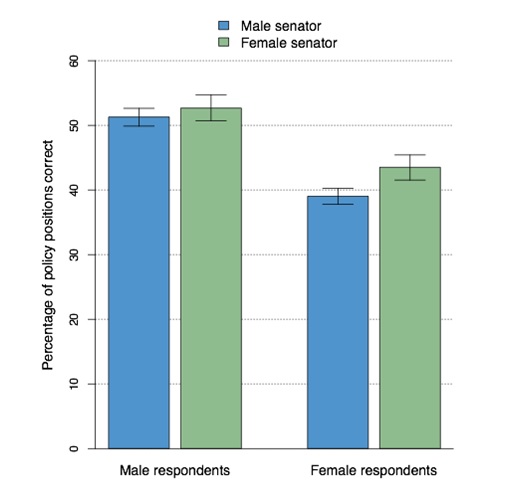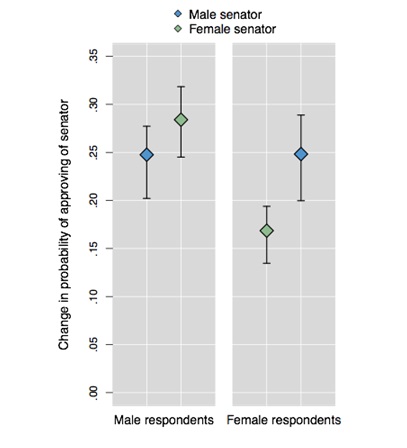 Descriptive representation (being represented by someone who shares your demographic characteristics) and substantive representation (being represented by someone who shares your policy preferences) are both important components of the legislator-constituent relationship. Some have suggested that descriptive representation breeds blind loyalty to politicians, which can weaken accountability for their actions. Philip Edward Jones evaluates the effects of descriptive representation of gender on female voters. He finds that while women are not more likely approve of a politician because of her gender, they are more knowledgeable about and responsive to female senators’ records and adjust their assessments accordingly.
Descriptive representation (being represented by someone who shares your demographic characteristics) and substantive representation (being represented by someone who shares your policy preferences) are both important components of the legislator-constituent relationship. Some have suggested that descriptive representation breeds blind loyalty to politicians, which can weaken accountability for their actions. Philip Edward Jones evaluates the effects of descriptive representation of gender on female voters. He finds that while women are not more likely approve of a politician because of her gender, they are more knowledgeable about and responsive to female senators’ records and adjust their assessments accordingly.
Does the descriptive representation of gender affect how constituents respond to their legislators’ substantive policy records? Previous research suggests two strikingly different expectations about how female voters respond to female politicians’ records in office.
On the one hand, some argue that descriptive representation leads to “blind loyalty” — that women may inaccurately assume they agree with female politicians on policy matters, or support them for symbolic reasons that have nothing to do with policy. By this account, the descriptive representation of gender weakens accountability for substantive representation by lulling voters into a false sense of security about their representatives’ actions.
On the other hand, some suggest that electing women may have an “empowering” effect on female voters used to being represented by male politicians. According to this theory, the descriptive representation of gender strengthens accountability by engaging female voters, leading them to be more aware of and responsive to their representatives’ policy record.

In my recent research, I assess these different theories using data from the 2010 CCES survey which questioned over 5,000 Americans about the policy positions their U.S. senators had taken on several high profile issues. This allows us to assess what respondents know about their senators’ records, and how they use that information to evaluate them – and critically, whether female voters respond to substantive representation differently when also represented descriptively.
To determine how knowledgeable constituents are about their senators’ records, I calculated the percentage of the senator’s policy positions that respondents to the survey correctly identified, and used various features of the respondent, their senators, and the degree of agreement between them to predict their accuracy. This includes the party of the senator and its interaction with their gender, since it may be easier to guess the positions of female Democrats given stereotypes about their relatively more liberal voting record. It also incorporates a string of factors shown to predict general political knowledge, including education, partisanship, and interest in current events.
Figure 1 presents the predicted percentage of roll call votes correctly identified for an average respondent, given different combinations of gender and descriptive representation. The brackets around the estimates signify 95% confidence intervals. All else equal, women correctly identified a greater percentage of their senator’s roll call votes when their senator was female (44%) than male (39%). In contrast, the percentage of positions male respondents correctly identified did not vary with the gender of the senator: the percentages are indistinguishable for male (52%) and female (53%) senators.
Figure 1: Predicted percentage of policy positions correctly identified, by gender of respondent and senator.
 These results suggest a small, but significant, effect of descriptive representation on knowledge of substantive representation. Women represented by women were more likely to know how their incumbent senators had voted, a cornerstone of democratic accountability. Further, this result does not appear to be the effect of the “novelty” of female senators or differences between state electorates that chose these incumbents in the first place: only women, not men, are affected by the gender of the senator.
These results suggest a small, but significant, effect of descriptive representation on knowledge of substantive representation. Women represented by women were more likely to know how their incumbent senators had voted, a cornerstone of democratic accountability. Further, this result does not appear to be the effect of the “novelty” of female senators or differences between state electorates that chose these incumbents in the first place: only women, not men, are affected by the gender of the senator.
To assess whether descriptive representation influences how constituents evaluate their representatives, I fit regression models predicting approval of the incumbent’s job. The models include the gender and party of senators and respondents, and the degree of policy agreement between them.
These models suggest there is no effect of descriptive representation on overall approval ratings. Holding policy agreement constant at 50% (meaning the respondent and senator agreed on half of the policies), women were equally as likely to approve of a male (probability=.32) as a female (.31) senator. Women were not more likely to approve of a politician simply because of her gender.
This does not mean that descriptive representation is irrelevant to constituents’ evaluations. In Figure 2, I estimate the change in the probability of approving of the senator given a change in policy agreement from 25% to 75%. The bullets represent the estimated shifts in approval, while brackets show the 95% confidence intervals.
Figure 2: Predicted changes in approval ratings given an increase in policy agreement, by gender of respondent and senator.
 For all respondents, increasing the degree of policy agreement increases the probability of approving of the senator. Not much news there. How much more likely they are to approve, however, varies significantly with descriptive representation.
For all respondents, increasing the degree of policy agreement increases the probability of approving of the senator. Not much news there. How much more likely they are to approve, however, varies significantly with descriptive representation.
Female voters are more responsive to female senators’ records. Shifting from 25 to 75% agreement is associated with a shift in the probability of approval of a male senator from .23 to .40, a difference of .17 [.13, .19]; for female senators the change is from .19 to .44, a difference of .25 [.20, .29]. Substantive representation has a bigger impact on women’s evaluations of female senators than their evaluations of male senators.
Once again, male voters do not have different responses to male and female senators. The changes in their probability of approval are statistically indistinguishable. Women, but not men, are more responsive to female senators’ records, suggesting that the “empowering” effects of descriptive representation for under-represented groups are responsible.
Politicians have a particular interest in paying attention to the needs and interests of those citizens most engaged with politics. If descriptive representation leads to increased engagement amongst women, then it may also lead female politicians to be more responsive to their preferences. Descriptive representation in a legislature might lead to substantive representation in government policy not just because of the different priorities and positions of female legislators but also because descriptively-represented voters are more aware of and responsive to their record.
Ultimately, the descriptive representation of gender strengthens accountability for the substantive representation of policy preferences, another potential argument in favor of increasing female representation in politics.
This article is based on the paper, “Does the Descriptive Representation of Gender Influence Accountability for Substantive Representation?” forthcoming in Politics & Gender.
Note: This article gives the views of the authors, and not the position of USApp– American Politics and Policy, nor of the London School of Economics.
Shortened URL for this post: http://bit.ly/1hPzq5a
_________________________________
 Philip Edward Jones– University of Delaware
Philip Edward Jones– University of Delaware
Philip Edward Jones is an Assistant Professor of Political Science and International Relations at the University of Delaware. His research is focused on public opinion and electoral behavior, and in particular how voters respond to political elites. His work on democratic accountability has appeared in numerous journals including the American Journal of Political Science, the Journal of Politics, and Political Behavior.





